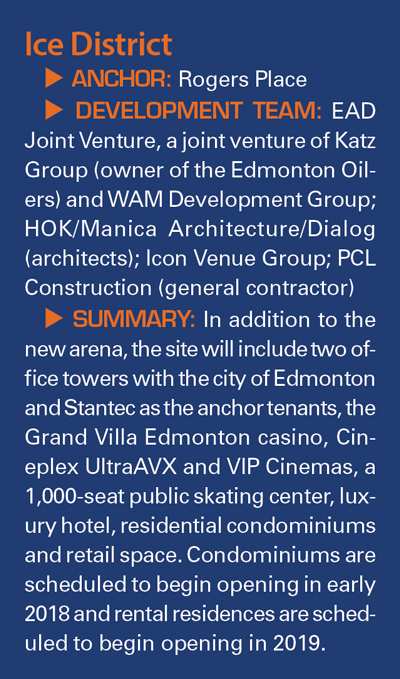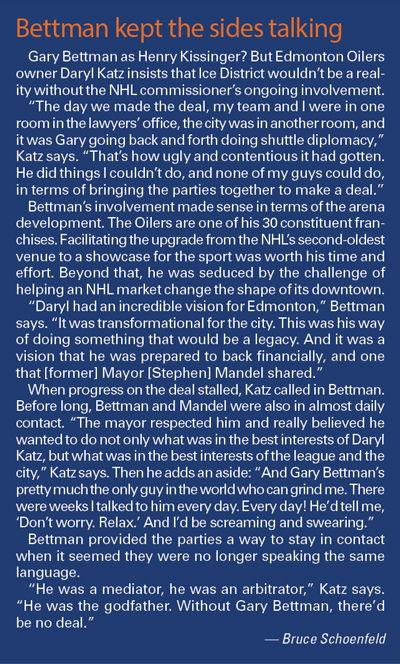If you want to see something you haven’t seen before, and may never quite see again, stand on the plaza outside the Winter Garden, the vast atrium that will serve as the main entrance when Rogers Place opens next summer. Look out over downtown Edmonton. The skeleton of the arena already has been completed, yet the holes in the ground around it are massive, far bigger than the arena itself.
The big pit with all those girders? That’s the foundation of a 68-story office tower, the largest Canadian building west of Toronto. To the left, a 55-story hotel will be attached to the Winter Garden. Near there, the city of Edmonton will move 3,000 employees into an office tower that’s under construction. The single-story Greyhound station across the street? Its lease runs until next year, but when it expires the building will be razed and 50 stories of condos erected.
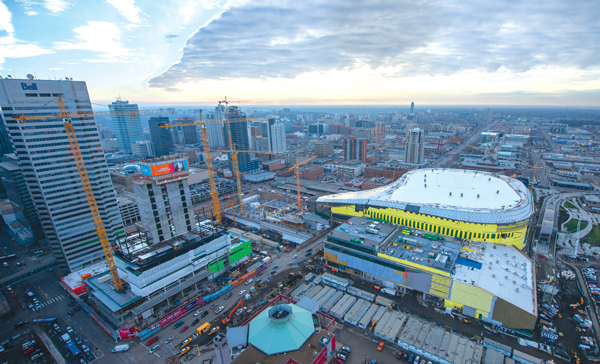 |
Cranes line the Edmonton skyline as Ice District starts to take shape.
Photo by: Jeff Nash / Oilers Entertainment Group |
The stainless-steel arena in the shape of an oil drop is being built off 104th Avenue. It will utilize technology never seen in a sports venue, according to Bob Black, executive vice president of the Katz Group, owner of the NHL’s Oilers, for whom the arena is being built.
His boss, Daryl Katz, reveals that the arena and its ancillary construction will cost some $750 million in Canadian dollars, or about $550 million U.S., far more than any previously revealed figure for the project. “You get football stadiums for that,” he crows.
“When I look at the site, and what we’re building, and the plaza there and everything else,” Katz says, “it shakes me up. It’s incredible, what we’re building.”
The 16.5 acres currently under development, coupled with 10 more that will constitute the second phase of the project, will create the second-largest mixed-use development ever built on the continent, after New York’s Hudson Yards. While business and entertainment complexes have been built to feed off sports venues, from Los Angeles to Columbus to London, nothing of this scale has ever been attempted.
“Even for an insider,” says Black, gazing out a window in the Katz Group offices that overlooks the development, “there is an element of the surreal to it.”
Called Ice District, its total of 4.4 million square feet will add up to more than a sixth of all the existing retail and commercial real estate in Edmonton’s downtown. Yet numbers don’t do justice to the scope of the project, which will utterly transform the core of one of Canada’s major cities.
“I knew on paper what it was supposed to be,” said Bill Daly, the NHL’s deputy commissioner, who visited earlier this year. “But when you go there and experience it in person, it takes on a whole new meaning.”
Ice District is a private-sector development wrapped around an arena funded by a partnership between Oilers owner Katz (pronounced to rhyme with “skates”) and the city, which will pay 47 percent of the costs from its budget. The rest will be funded by taxes, including a community revitalization levy and a ticket surcharge, and by lease revenue.
Katz originally committed to invest at least $70 million U.S. on development around the arena. So far, he has spent 20 times that, or a neat $2 billion in Canadian dollars. And there’s plenty more to come. “In phase two,” he says, “we’re going to build 4,000 residential units. We’re going to build a city.”
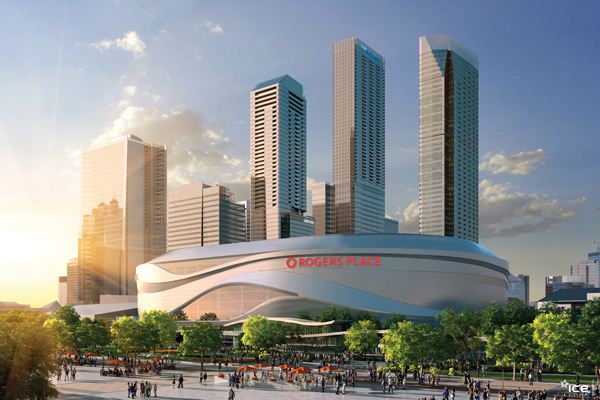 |
The project will create the second-largest mixed-use development on the continent.
Photo by: Ice District |
Katz has hired AEG, which developed L.A. Live and later iterations from Kansas City to Berlin, to help with the planning and the rollout. In truth, though, Ice District will be bigger and go up far faster than anything AEG has done. Staples Center opened in 1999 and 16 years passed before a hotel was built on adjacent land. In Edmonton, that time lapse will be less than 16 months. And Ice District — without the definite article, please — is a true mixed-use development.
“L.A. Live is great,” Katz says. “But they don’t have office. We have 1.2 million square feet of it. That gets a huge number of people to your site on a daily basis. And all those office workers need places to eat and things to do.”
It isn’t all Katz, either. Other developers — such as John Day, who has reconstructed the iconic Kelly Ramsey building and is putting a skyscraper atop it — had committed to the downtown redevelopment process even before Ice District contracts were signed. Others, such as Toronto’s Brad Lamb (who stars in his own real estate reality show), want to be part of the opportunity.
“The arena’s half a billion dollars,” Day says. “Big deal. It is a big deal — I don’t mean to be critical about it at all. But there’s four times the amount of that going on downtown.”
And that, city leaders insist, is for projects that have been announced. “I’ve had some meetings recently,” said Scott McKeen, who represents downtown Edmonton on the City Council. “And I would suggest to you that you ain’t seen nothing yet.”
■ ■ ■
How did all this happen in Edmonton? A blue-collar city of just 800,000 and the provincial capital, it serves as the main processing center for the oil of northern Alberta. It has long been overshadowed by Calgary, due south on Highway 2. The largest metropolis between Vancouver and Toronto, Calgary had the wherewithal to host the 1988 Olympic Winter Games and basks in its Wild West image and reputation for conspicuous wealth that position it as a Dallas-of-the-North. It also sits an hour’s flight closer to U.S. markets.
Edmonton’s downtown hasn’t recovered from the same late-20th century migration of businesses, retail outlets and sports facilities out of city centers that continues to plague many metropolitan areas. What remains is a hodgepodge of outdated office space, one-story law firms and beauty salons that have gotten older and more unsightly.
“Downtown has been limping along for the past 30 years,” McKeen says. “And there hasn’t been investment from the city because they kept building out and out. That was our development strategy.”
But while they were “building out,” Edmonton prospered; by some estimates, its standard of living is North America’s best. The net population gain to the area in 2014 was 65,000. But all the new development took place on the edges. “From the early ’90s to the present, there has only been one new office tower constructed in the downtown corridor,” Black says.
Ice District will shift the momentum back downtown. It plays to a trend across North America, from Oakland to Brooklyn, of revitalizing neglected urban centers. But the process is usually gradual, not all at once.
“One of the biggest retail brands in the country said to me, ‘We’re worried about the impact this is going to have on our flagship store in Canada at the West Edmonton Mall,’” says Glen Scott, the Katz Group’s senior vice president for real estate. “I said, ‘Robert, that’s exactly what we think is going to happen,’ … It’s naïve to think that adding billions of dollars of money into one area in a very short period of time isn’t going to have a massive effect.”
Katz is a native son who had a wide-angle vision on how to transform the city. “Development is a risky endeavor in the best of times, and given the price of energy, this isn’t the best of times,” says Phil Milroy, a regional developer without a direct stake in Ice District. “All the pieces have to come together or something like this will fail. There’s no question that nobody other than Daryl Katz could have done this.”
And, crucially, Katz owns the Oilers. One of the largest master-planned urban development projects in the history of democratic society wouldn’t have happened if 60 percent of Edmonton’s downtown hadn’t been either a one-story building or a surface parking lot, and it wouldn’t have happened without the financial and intellectual wherewithal of Katz. But even with all that, it couldn’t have happened without a hockey team — and a last-place one at that.
“There needs to be a connectivity, a reason to do this,” explains NHL Commissioner Gary Bettman, who was intimately involved in the project (see story below). “Daryl had the vision and resources, but there needed to be a catalyst. The Oilers were the catalyst.”
Edmonton’s relationship with the Oilers is unlike its relationship with any other entity in the city — and perhaps unlike any North American city’s relationship with its sports team.
“The Oilers are unique, they just are,” says Winnipeg Jets majority owner Mark Chipman. “They have a unique
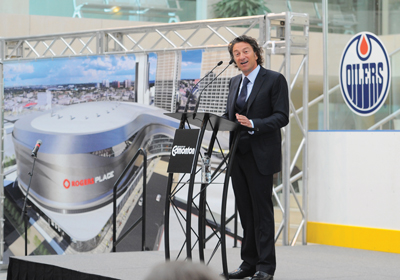 |
Daryl Katz saw Rogers Place as a way to revitalize his hometown.
Photo by: Andy Devlin / Oilers Entertainment Group |
place because of their history, and the importance of that history in the community.”
Like cities such as Oklahoma City and Portland, Winnipeg and Jacksonville, Edmonton has a single major league team — unless you count the CFL’s Eskimos (and locals don’t.). Unlike those cities, Edmonton is cold and dark for months at a time. A 2012 story in the Huffington Post put it succinctly: “Edmonton is the northernmost city in North America, suffering from long, cold, dark winters where it sometimes feels like all there is to do is watch hockey.”
And for half a generation, the hockey the locals watched was the finest in the world. “There was a long hockey history here before the NHL,” says Kevin Lowe, who played on five Stanley Cup champions in Edmonton, coached the team and served as its general manager, and now works for Katz as the vice chairman of the Oilers Entertainment Group. “But what the Oilers of the NHL did was give the city a stamp not only nationally but internationally. So someone can be in the oil and gas industry, he can be in Russia or the Middle East, and they’d hear, ‘Oh, Edmonton. The Oilers! Gretzky!’ It was a source of pride.”
Despite a decade of losing, it still is. When you arrive at Edmonton International Airport, the first thing you see is a display of life-sized cutouts of Oilers players at baggage claim.
From the start, Katz saw the arena as a way to revitalize his hometown. “I can’t say I would have had the same interest in just buying a hockey team,” he says. “It lost a fortune the year I bought it. It was a huge risk. But the Oilers were the price of admission.”
The success of Ice District, Katz believes, will insure the long-term competitiveness of the Oilers in Edmonton. “One of the big reasons I needed to do what I did,” Katz says, “is because it’s the only chance we have to re-create what we had in the ’80s.”
That means new revenue streams, including 37 different types of seating inventory at Rogers Place. But it also means creature comforts that will make playing for the Oilers even more enticing. Luxury condominiums will be linked to the arena by an underground tunnel, so players won’t have to step outside in inclement weather. The home dressing room is 30,000 square feet, notes Bob Nicholson, OEG’s chief executive officer, “so players will want to stay there all day. It all ties back to Daryl’s passion for the Oilers. He saw what Wayne Gretzky, Mark Messier and Kevin Lowe did for the city. He’d love to have that back.”
Some see Ice District as a template for development around the continent. But those with deep Canadian ties understand how singular the Oilers’ situation is. “There’s a deep, deep passion for that team,” Chipman says, “and you’re getting this project built on the extent of that passion. With the Oilers involved, it’s not surprising that they were able to get the city behind this.”
■ ■ ■
Edmonton’s civic leaders are giddy at the prospect of a new downtown district arriving almost fully formed at their doorstep. At the Downtown Business Association’s annual fall luncheon at the Edmonton Westin last month, McKeen pulled on a T-shirt that said “It Took Almost 3000 Years to Build Rome. We’re Doing it in 10” over his suit jacket. Then local TV anchor Gord Steinke, who was serving as master of ceremonies, bragged about Ice District. “Just made a quick trip to New York City,” Steinke said, “and I noticed some of the buildings there are about as tall as some of them we’re going to have.”
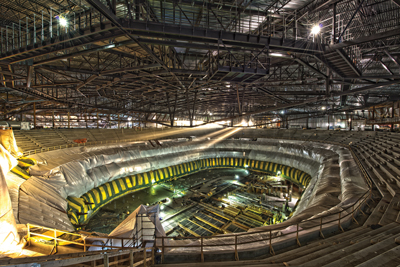 |
Work continues last week on Rogers Place, which will provide modern amenities to Oilers fans.
Photo by: Jeff Nash / Oilers Entertainment Group |
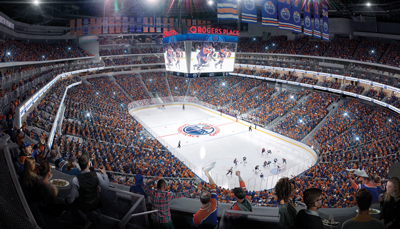 |
| Photo by: Ice District |
Taking it in, Black couldn’t hide a smile. “It’s incredibly, incredibly gratifying to sit here and listen to this,” he says.
“Because there were dark days. There were times when this project hung in the balance and we felt like we were banging our heads against a wall.” For years, the arena project — and any downtown development that might come with it — was the most controversial topic in town. “Now it’s a love-in,” says Scott, who, like Black, has known Katz since they all went to junior high together in Edmonton. “It wasn’t always a love-in.”
The Oilers needed a new arena. Nobody disputed that. City-owned Rexall Place, formerly Northlands Coliseum, had all the history associated with the winning of five Stanley Cups. It also had the limitations of a building built in 1974 as the home of a World Hockey Association team. “It wasn’t an option for us to continue to play in the second-smallest, second-oldest arena in the NHL’s second-smallest media market,” Black says. “We were also the only team in the NHL that wasn’t receiving non-hockey revenues. We had a very compromised situation.”
But where the new facility would be situated, and who should pay for it, became a raucous debate. The cheapest solution for the city would have been to retrofit the existing site in a sterile pocket outside downtown. Actually, an even cheaper solution would have been for Katz, who had paid $200 million in Canadian dollars for the team in 2008, to finance a venue himself.
“People got it in their minds that you’re dealing with a billionaire who could pay for the entire arena and a district around it,” says Rick Daviss, Edmonton’s Arena Project District executive director, who oversees the area’s development for the city. “Well, just because he could doesn’t mean he should.”
Katz started to accumulate downtown parcels in 2007, even before he bought the team. “Before there was even a chance to build an arena,” he says, “I was in for $300 million.”
Stephen Mandel, the city’s popular mayor at the time, didn’t always get along with Katz. But Mandel also felt that a new Oilers arena offered a rare opportunity to stimulate the re-creation of the city core. “The mayor and the team owner had a shared vision, even if they didn’t always realize it at the same time,” Bettman says.
Though the sides had similar goals, negotiations were contentious. Katz was a billionaire asking for money, which is never good for public relations. And his discomfort giving interviews meant that his passion for the team and town were communicated by surrogates. On the other side, you had a city with plenty of metaphoric potholes to fill that was considering using tax revenue to subsidize a sports franchise. That’s rarely a popular stance, even among rabid fans.
As a result, says Katz, “It was a terrible process. They hated me. We had death threats. But that’s what gets me
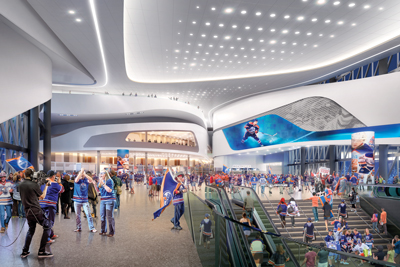 |
The Winter Garden will serve as the arena’s main entrance.
Photo by: Ice District |
enthusiastic about something, when people say it’s impossible. That’s what makes it worthwhile.”
McKeen, now the city councillor, was an Edmonton Journal columnist with strong opinions during those years. He recalls telling Mandel at one point that he’d grown tired of hearing Katz’s demands. “I was ready to tell him, ‘Take your team and leave,’” McKeen says now. Mandel, no easy negotiator himself, said he understood. “‘I totally get that sentiment,’” McKeen says Mandel told him. “‘But it’s not about the Oilers. It’s about downtown.’”
Except that, for a broad segment of the Edmonton population, it was about the Oilers. At one point, with negotiations in a particularly parlous state, Katz led an Oiler delegation that included Gretzky to Seattle, a city lacking an NHL franchise. It was a clumsy move that made Katz look like the worst sort of opportunist. He’d been given charge of the sanctum of Edmonton’s pride, the one asset that set it apart from a dozen similarly sized cities around the continent, and he seemed to be shopping it elsewhere.
“Daryl’s a very, very, very smart man,” says hockey hall of famer Paul Coffey, who spent his first seven NHL seasons with the Oilers. “He’s going to look to see what’s out there. That’s the game you play as an owner. But there’s too much to lose for the team not to be here. There’s half a dozen other teams in the league that aren’t doing well. Edmonton is not one of them.”
“I didn’t need to threaten anybody,” Katz says now. “Everybody knew if the Oilers didn’t get a new arena, we wouldn’t be able to sustain a team.”
Still, the reaction — predictably — was outrage.
On Sept. 29, 2012, Katz apologized with a full-page advertisement in the Journal. “I took for granted your support and your love of the Oilers,” it read. “That was wrong, and I apologize … The simple fact is that the Oilers need Edmonton and Edmonton needs the Oilers. Each is an integral part of the fabric and identity of the other.” The apology, Katz says now, came from the heart. “I was sorry for me, for the city, for all those Oilers employees, sorry for Wayne who just happened to be there because his son is friendly with my son,” he says. “I was sorry most for our fans, who might think that we would discredit the Oiler legacy in Edmonton by suggesting the Oilers ever wouldn’t be there. It was bad all the way around and it blew up, and I was ultimately accountable. I had to apologize. It was the only thing to do.”
The emergence of Rogers Place as a tangible structure has been the start of a turn in the public perception toward Katz and the project, though feelings remain mixed. “There may be a day when they hold a parade for Daryl Katz,” McKeen says, “but he remains a very controversial figure in Edmonton.”
■ ■ ■
On a late October afternoon, Katz is sitting on a patio at the Bighorn Club in Palm Desert, Calif., watching his Oilers play Minnesota on a TV feed brought in for his benefit. Katz spends nearly half his time in Palm Desert, where the weather could hardly be more different than back home. At Bighorn, the temperature hit 93 during the day and is still in the mid-80s as night falls. Still, Katz wears a long-sleeve pullover shirt with a black Oilers zip-up jacket over it.
A man approaches. “I’ve got a deal for you,” he says. It’s R.D. Hubbard, the horse racing magnate who serves as
chairman of Bighorn. Katz invites him to sit down. They already own a business together in India — a football league, improbably enough.
You might think that remaking the center of Edmonton and owning his favorite sports team would be enough for Katz. He keeps his holdings — an estimated $3 billion worth — divided into four “verticals,” as he calls them. One is pharmacy, which made him rich through the Medicine Shoppe and Rexall brands. A second is sports and entertainment, including Ice District and the Oilers. A third is real estate; his 70 shopping centers and 6 million square feet of total holdings rank him among Canada’s largest property owners. Finally, there are investments, mostly in biotechnology.
It’s a lot to keep straight, but Katz knows that everything could just about run on its own if it had to. So when someone approaches with an offer to discuss, Katz is ready to listen. “You can’t just look in the mirror and smile at yourself and say, ‘I’m so great,’” he says. “You’ve got to get on to the next thing.”
Hard as it is to believe about a development that won’t even open until next summer, Katz already looks back with nostalgia on the creation of Ice District. “That was the most exciting time of my life, working on that deal,” he says wistfully. “Yelling and screaming and pacing.” He laughs. “It doesn’t get any better than that.” At one point, he says, his neighbor in Palm Desert was forced to move rather than deal with the collateral clamor. “I’d go on the phone and pace outside,” Katz says. “I was screaming. I’m fairly animated when I’m on the phone, especially when I’m talking with Commissioner Bettman.”
At that time, the family was living part of the year in Vancouver. “We’d walk the seawall together,” says Katz’s wife, Renee. “And he would literally be on the phone the whole time, never in the moment, never seeing the beauty of the ocean.”
Katz loved it. “And now it’s almost anti-climactic for me,” he says. “Now it’s being built. My personal work on it is done.”
When the suggestion is made that Ice District — Katz’s name, by the way — will be his lasting contribution, Katz doesn’t disagree.
He talks about the concept being extendable, how Jeff Vinik of Tampa has visited and Detroit’s Mike Ilitch is coming. But he understands that the confluence of developable real estate, a visionary owner, and an iconic franchise doesn’t come along often, especially on this scale.
“To this day,” he says, “I don’t think anyone really appreciates what we’re building. Nobody really gets it. This is the best-kept secret because I don’t have any partners, there are no pension funds involved, we’re not out selling this or calling attention to it. But as the buildings start to come up, you won’t be able to deny it.”
He sits up in his chair, his finger in the air, his eyes flashing, as if he’s back on the phone with Bettman.
“Nothing like this,” he says, “has ever been built before.”
Bruce Schoenfeld is a writer in Colorado.




